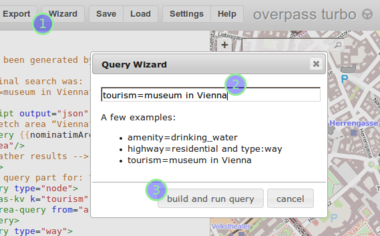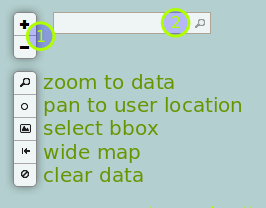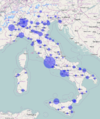Overpass turbo
Servers status · Versions · Development · Technical design · Installation · XAPI compatibility layer · Public transport sketch lines · Applications · Source code and issuesOverpass turbo · Wizard · Overpass turbo shortcuts · MapCSS stylesheets · Export to GeoJSON · more · Development · Source code and issues · Web siteOverpass Ultra · Examples · Overpass Ultra extensions · MapLibre stylesheets · URL Params · more · Source code and issues · Web site
| Overpass turbo | ||||||||||||||||||||
|---|---|---|---|---|---|---|---|---|---|---|---|---|---|---|---|---|---|---|---|---|
| Author: | Martin Raifer | |||||||||||||||||||
| License: | MIT License | |||||||||||||||||||
| Platform: | Web | |||||||||||||||||||
| Version: | 2bdb879 (see help dialog) (2025-04-09) | |||||||||||||||||||
| Languages: | English, Catalan, Chinese (China), Chinese (Taiwan), Croatian, Czech, Danish, Dutch, German, Greek, Esperanto, Estonian, French, Galician, Hungarian, Italian, Japanese, Latvian, Norwegian, Polish, Portuguese, Brazilian Portuguese, Russian, Slovenian, Spanish, Ukrainian, and Vietnamese
| |||||||||||||||||||
| Website: | overpass-turbo.eu | |||||||||||||||||||
| Source code: | tyrasd/overpass-turbo GitHub | |||||||||||||||||||
|
A web-based data filtering tool for OpenStreetMap using the Overpass API. |
||||||||||||||||||||
| ||||||||||||||||||||
Overpass turbo (overpass-turbo.eu) is a web based data mining tool for OpenStreetMap.
It runs any kind of Overpass API query and shows the results on an interactive map. Using it can get technical quite quickly: beginners may find the "wizard" a good place to start.
This project is maintained by Martin Raifer. The source code is found on github GitHub. A huge thanks goes to Roland who created the Overpass API, without which this tool wouldn't exist.

Use cases
Instances
- Stable version: https://overpass-turbo.eu
- Latest version: https://tyrasd.github.io/overpass-turbo
- Swiss edition: https://overpass-turbo.osm.ch
For the mapper
The Overpass API can be a great tool for mapping, as it is very powerful at filtering OSM data. With overpass turbo, there is an easy way to quickly run any Overpass query and inspect the results in a user friendly manner. Here are some ideas where using overpass turbo can be a handy tool while mapping:
- Searching for (rare) spelling mistakes or breaks with naming conventions over a large area.
- Looking for special POIs which are not drawn on the map.
- Inspecting POIs (e.g. place nodes) which are distributed evenly over large areas.
- Showing spatially large features (boundaries, rivers, complete motorways, PT-networks, ...) and loading them directly into an editor.
- when you only need a filtered portion of OSM data.
For the developer
Overpass turbo can be a tool for developers, too:
- Testing and developing more or less complicated Overpass API queries.
- Converting OSM data to the geoJSON data format.
- Creation of mock-ups of clickable or static maps highlighting selected OSM features.
For the general public
Overpass turbo is also useful for filtering out certain things you are looking for.
For the gamer
Overpass turbo is well known by many Pokémon Go players, who use the tool to map out possible spawns and nests.[1][2] Some players in particular have created overpass turbo scripts to find such nests (script), and also to find EX Raids (script).[3][4][5] There is also a GitHub project that allows you to use overpass turbo for querying habitats.
Running queries
Put your Overpass API query (see Language Guide) into the editor, hit the Run button, and get amazed by the goodness of the OSM data displayed ;)
overpass turbo displays as much data as possible (see map key below). When clicking on an object, a popup shows all the information of the selected node, way or relation: type and id, tags, coordinates, relationship memberships and meta data are shown, if available.
Please note that you need a somewhat recent web browser for using overpass turbo. Opera, Chrome and Firefox have been tested and work.
Query wizard

There is a Query Wizard that assists one with the writing of Overpass queries. It is designed to transform simple, human-readable search terms into functional Overpass queries. Here is an example: To get restaurants, now all you have to do is fire up the Wizard and enter Restaurant. Alternatively, one can also type in the appropriate tag amenity=restaurant.
Read more about the Query Wizard on its own subpage.
Map key

- objects:
- (1,2) POIs (nodes with tags) are shown as circles with a yellow filling and a thin blue outline,
- (3,4,5) ways as bold blue lines and
- (6,7,8) areas as yellow polygons with a thin blue outline.
- (2,5,8) Pink lines and outlines mean that an object is part of at least one relation.
- (4,7) Dashed lines mean that a line or area has an incomplete geometry (most likely because some of its nodes have not been loaded).
- (9) Circles with a red filling represent ways or polygons that are too small to be displayed normally (to switch this off and show the small feature instead: Settings → Map → "Don't display small features as POIs.").
Query shortcuts
One can use handy shortcuts in the query which are auto-expanded before the execution of the query:
- {{bbox}} – the bounding box coordinates of the current map view.
- {{center}} – the center coordinates of the current view.
- Arbitrary shortcuts can be defined easily: just put {{shortcut=value}} somewhere in the script.
- more shortcuts
Map controls

Keyboard shortcuts
| General | |
| Ctrl+↵ Enter | Run the current query |
| Ctrl+I | Start the Query Wizard |
| Ctrl+O / Ctrl+S | Load (open) / Save a query |
| Ctrl+H | Open help dialog |
| Esc | Close/dismiss dialogs or message boxes |
| Query Editor | |
| Ctrl+Z / Ctrl+Y | Undo / Redo |
| Ctrl+C / Ctrl+X / Ctrl+V | Copy / Cut / Paste |
Saving and sharing queries
Saving and loading

It is possible to save queries locally or on an OSM account for later reuse. Queries saved on OSM are accessible from everywhere after logging in, while locally stored queries are saved directly in your browser's ![]() local storage (one has a separate set of locally stored queries for each browser).
local storage (one has a separate set of locally stored queries for each browser).
Examples
For a start, there are a few example queries preloaded in the Examples section of the Load tool. Take a look at them for a short glimpse of what overpass can do. You can find some more examples on the following page.
Sharing
You can also share your queries with other people via permalinks. The Share tool gives you a link for your query which you can send to a friend or post somewhere.
Example: This link is going to display all peaks of the ![]() Dolomites.
Dolomites.
Templates
Overpass turbo also comes with a preloaded set of templates, which can be used instead of share-links for simple use cases (like a simple key-value search).
MapCSS Styling
It is possible to style the results of an Overpass query with MapCSS. Stylesheets can be included with a special "mustache"-tag: {{style: ... your mapcss stylesheet here ... }}.
-
line styles
-
color coding
-
icons
-
a simple thematic map
-
markers with text
See more info at Overpass_turbo/MapCSS
Exporting Results


The Export dialog holds various export options for the query and/or data loaded by the query. For example, you can convert the current map view to a static png image or a (fullscreen) interactive map, or do some things with the raw query like converting between the query languages or instruct JOSM to load the data returned by a query.
Data
- as geoJSON
OSM data after converted to geoJSON. Read more.
geoJSON. Read more. - as GPX
Useful for uploading waypoints to a GPS device. Make sure you add "center" to your query to have al features as points.[1] - raw data
The raw OSM data (in XML or JSON). - raw data from Overpass API interpreter
A direct link to the result of the query returned by the Overpass-API interpreter. - load into JOSM
Instructs JOSM (or any other editor supporting the RemoteControl protocol) to load the result of the current query. Note that this only works for queries returning valid OSM-XML with meta data. - save as gist
Publishes the data directly as a Gist (the pastebin service by Github that loves maps). Provides a link to edit an OSM dataset with geojson.io, the online geojson editor.
Map
- as png image
The current map including the displayed data as a png image. By default, The exported png includes a scale and an osm attribution string. - as interactive Map
A fullscreen, clickable map showing the results of the current query. POIs and Ways are clickable, just like in overpass turbo itself. - get current map state
Prints bbox, center and zoom information of the current map view.
Query
- as text
The current query as a text file - convert to xml
The current query converted to an OverpassXML-formated query. - convert to (compact) OverpassQL
The current query converted to a (compact) OverpassQL query.
Settings
There are some settings for customizing turbo. For example, one can activate alternative Overpass-API servers or set a custom background map.
- General Settings – contains settings about the Overpass-API server.
- Editor – some GUI customizations.
- Map – options for the background tile source and the appearance of the map.
- Sharing – settings regarding the generation of permalinks.
- Export – e.g., what to include on exported png-images
History
On May 11, 2017, the code was reformatted in Prettier for version 12.16.[6]
Feedback, bug reports, feature requests
If you would like to give feedback, report issues or ask for a particular feature, please use the issue tracker on github or the discussion page on this wiki.
References
- ↑ Batanes, Benjie (September 20, 2016). "Pokemon GO Guide: How To Use Overpass Turbo To Look For Spawns & Nests". iTech Post. Retrieved on August 8, 2020.
- ↑ "A comprehensive guide on how to trigger EX Raids". Pokemon GO Hub. Retrieved on August 8, 2020.
- ↑ u/nmitch3ll (September 27, 2016). "OSM Query To Identify Possible Nests". Reddit. Retrieved August 8, 2020.
- ↑ u/Perrin (August 18, 2017). "OSM Query for Map Features Used In Pokemon Go". Reddit. Retrieved on August 8, 2020.
- ↑ Tntnnbltn (February 26, 2015). "Determining Which Gyms will Get you Ex-Raid Passes for Mewtwo: Part 2". Pokebattler. Retrieved on August 8, 2020.
- ↑ Legner, Simon (May 9, 2017). "Use Prettier for consistent code formatting". Github. Retrieved on August 8, 2020.
See also
- Overpass API – Language Guide
- Language reference
- Overpass API by Example
- Advanced examples
- Examples of interesting overpass queries
- Sparse Editing
- FAQ
- MapCSS
- Overpass Ultra
- More:
- Overpass turbo
- Overpass API
- OSM Query [ dead link ] – A simple frontend to query by a comma-separated list of tags and users
- Geographic data mining and visualisation for beginners - Overpass turbo tutorial
- Bellingcat OpenStreetMap search - Bellingcat describes it as "a dramatically simplified version of the Overpass query language tool"
- Easy Overpass - An assistant to make specific custom queries to Overpass turbo and Overpass Ultra.
Important pages related to Overpass turbo can be added to Template:Overpassapi.







